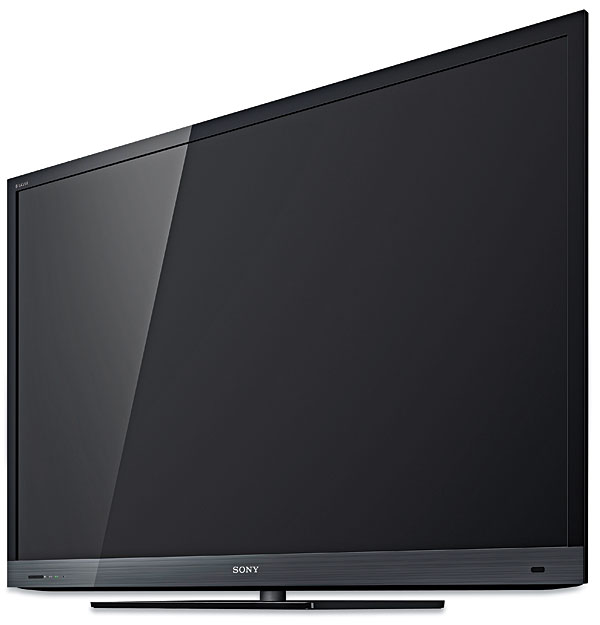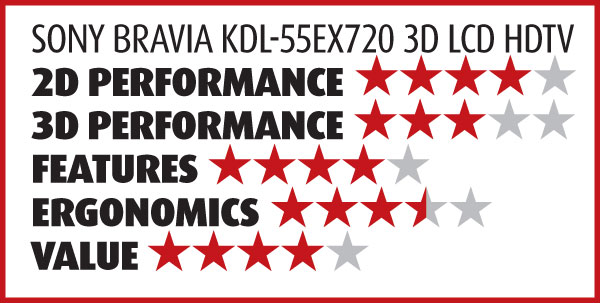Sony Bravia KDL-55EX720 3D LCD HDTV Page 3
My first reaction to the Sony was that it didn’t look quite as crisp as some of the other LCD sets we’ve reviewed recently. It wasn’t soft by any means, just not as overtly detailed. But nothing in the measurements suggested any resolution issues. I increased the Sharpness control to +10 (maximum 100). I set the Edge Enhancement control to Low and the Detail Enhancement to Medium, which also provided some benefit, although the very subtle changes that resulted may have been more fanciful than real. My initial reservations then dissipated quickly. The set’s detail on HD sources was never less than fully satisfying, and often impressive. From single strands of hair and the subtlest textures in clothing, to Naomi Watts’ stunning (computer-enhanced?) eyes in chapter 7 of King Kong, HD looked consistently sharp. Of course, SD was less so, but only the poorest program material—usually limited to the worst analog cable channels—ever turned soft and pasty.

For an edge-lit set with no pretense to dynamic LED lighting, the KDL-55EX720’s blacks and shadow detail were often startlingly good. Fadeouts between scenes dropped quickly and smoothly to total black as the LEDs turned off completely. Blacks weren’t quite so subterranean with even the subtlest hint of illumination from the source, but they challenged the capabilities of our reference light meter (see HT Labs Measures). Only rarely did I see a hint of the gray fog that can obscure dark scenes on some edge-lit LCDs. For example, on Stargate: Continuum, the star field that opens the disc wasn’t impressive, but the night scenes of a tramp steamer on the ocean in chapter 3 left little to be desired. The dark sequence in the Russian gate installation looked good, although I’ve seen it better. On King Kong, the Sony handled most of the dark scenes well, including Kong’s reunion with Ann on a dark New York street in chapter 48. Still, a few scenes (Ann’s capture by Kong; the insect pit) looked a bit too bright. The slightly higher black levels at the edges of the screen, which I noted in the earlier discussion of uniformity, also intruded a bit in very dark, low-contrast scenes, or on a full-black screen in the instant before the image fades to total black.
The –1 setting of the Sony’s Gamma control worked best with most material (zero for 3D), though one step higher or lower worked better with some sources. The set’s gamma was higher (it produced a darker image) at the low end of the brightness scale than at the top end. Theoretically, gamma should be constant from near black to near white.
The Sony’s off-axis performance was mediocre—a shortcoming of many LCD designs. You’ll want to grab that center seat to view the set at its best, and no one who cares at all about image quality will want to sit much more than 25 to 30 degrees to the side.
Deeper, Deeper
The Sony doesn’t come with 3D glasses; they will run you an extra $150 per pair. However, the transmitter that synchronizes with the glasses is built into the set. I found Sony’s glasses tolerable when I wore them over my regular glasses, but they weren’t particularly comfortable.
The Sony’s 3D Display control (in the 3D menu) offers settings for different 3D formats. With a true 3D source, there’s a 3D Depth Adjustment that worked best for me at its mid (zero) setting. A 3D Glasses Brightness control offers three settings; I chose Auto. There’s also a Simulated 3D Effect control that’s only accessible in the 2D-to-3D conversion mode. The conversion is reasonably effective, although it’s considerably less impressive than true 3D.
The Sony produces an exceptionally vivid, deep, bright, true 3D image. While the measured brightness was well short of 2D (as expected), the subjective brightness was the best I’ve yet experienced from a flat-panel, active-glasses 3D HDTV—a surprising result given the set’s modest 2D brightness. The Sony’s calibrated 3D color was also the best I’ve yet seen from a 3DTV.
However, the ghosts in the machine literally were ghosts. While the primary foreground subjects in 3D scenes rarely looked less than pristine, background objects produced more 3D ghosts than I’ve seen in other sets. Most of the time, when I focused my attention on the foreground details, I didn’t notice them. And they varied with the source—rare on Tron: Legacy, intermittent but clearly visible on Tangled, and frequent on Avatar. No combination of the 3D controls helped.
With many active-glasses 3D sets, the brightness of 3D images reduces when you tilt your head. With the Sony, even a small head tilt resulted in even more of those ghost-like double images, only this time, they were everywhere. I was constantly shifting my head to keep the 3D as sharp and locked in as possible.
Conclusions
The Sony KDL-55EX720 is a fine value as a solid-performing 2D set, with accurate color, good detail, and some of the best black levels and shadow detail I’ve seen in this price range. In 3D, it shows considerable ghosting. While that may put off some viewers, others will be drawn to the set’s bright, vividly dimensional, and (accurately) colorful 3D images.

- Log in or register to post comments











































